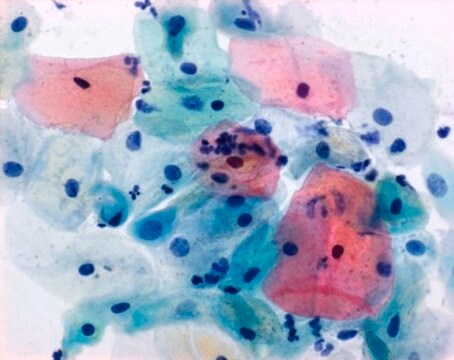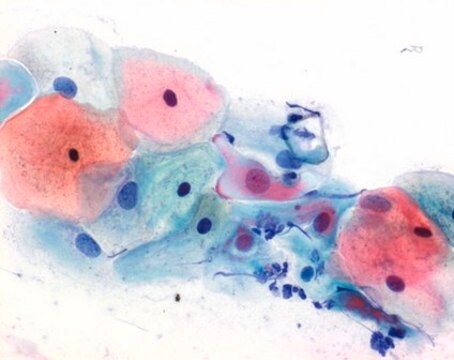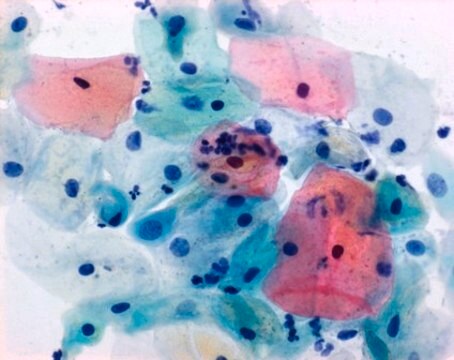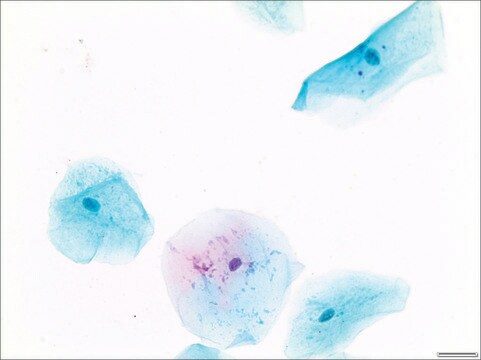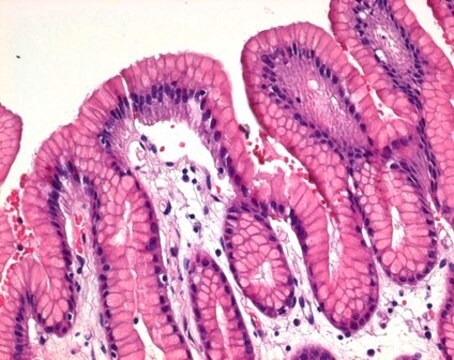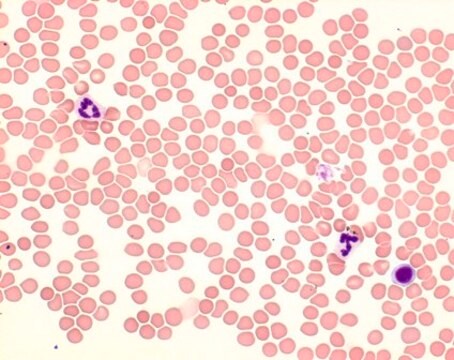推荐产品
品質等級
形狀
liquid
IVD
for in vitro diagnostic use
技術
microbe id | staining: suitable
pH值
7.0-7.5 (20 °C in H2O)
轉變溫度
flash point 17 °C
密度
0.83 g/cm3 at 20 °C
應用
clinical testing
diagnostic assay manufacturing
hematology
histology
儲存溫度
15-25°C
一般說明
Papanicolaou′s solution 2b Orange II solution - for cytology, is a ready-to-use solution used for human-medical cell diagnosis and serve the purpose of the cytological investigation of sample material of human origin, for example, cervical smears. Papanicolaou′s technique is the most used staining procedure for cytological specimens and is intended for the the staining of exfoliative cells in cytological specimens.
In the first step, the cell nuclei are stained either progressively or regressively with a hematoxylin solution, (Hematoxylin solution modified acc.to Gill II, (Product number 1.05175),
Papanicolaou′s solution 1a Harris hematoxylin solution, (Product number 1.09253) or Papanicolaou′s solution 1b Hematoxylin solution S, (Product number 1.09254). Nuclei are stained blue to dark violet. In the progressive hematoxylin staining method, staining is carried out to the endpoint, after which the slide is blued in tapwater. With the regressive method the material is over-stained and the excess of staining solution is removed by acid rinsing steps, followed by the bluing step. The structures of nuclei are more differentiated and better visible by the regressive method. The second staining step is cytoplasmic staining by orange staining solution, (Papanicolaou′s solution 2b Orange II solution, (Product number 1.106887) or Papanicolaou′s solution 2a Orange G solution (OG6), (Product number 1.06888)), especially for demonstration of mature and keratinized cells. The target structures are stained orange in different intensities. In the third staining step is used the so-called polychrome solution, a mixture of eosin, light green SF and Bismarck brown, Papanicolaou′s solution 3a polychromatic solution EA 31, (Product number 1.09271), Papanicolaou′s solution 3b polychromatic solution EA 50, (Product number 1.09272), Papanicolaou′s solution 3c polychromatic solution EA 65, (Product number 1.09270), or Papanicolaou′s solution 3d polychromatic solution EA 65, (Product number 1.09269). The polychrome solution is used for demonstration of differentiation of squamous cells. Papanicolaou′s solution 2b Orange II solution gives a more intense reddish staining result with mature and keratinized squamous cells than Papanicolaou′s solution 2a Orange G solution (OG6) - for cytology.
The 500 ml bottle provides 1500 - 2000 stainings. For more details, please see instructions for use (IFU). This product is registered as IVD and CE marked.
In the first step, the cell nuclei are stained either progressively or regressively with a hematoxylin solution, (Hematoxylin solution modified acc.to Gill II, (Product number 1.05175),
Papanicolaou′s solution 1a Harris hematoxylin solution, (Product number 1.09253) or Papanicolaou′s solution 1b Hematoxylin solution S, (Product number 1.09254). Nuclei are stained blue to dark violet. In the progressive hematoxylin staining method, staining is carried out to the endpoint, after which the slide is blued in tapwater. With the regressive method the material is over-stained and the excess of staining solution is removed by acid rinsing steps, followed by the bluing step. The structures of nuclei are more differentiated and better visible by the regressive method. The second staining step is cytoplasmic staining by orange staining solution, (Papanicolaou′s solution 2b Orange II solution, (Product number 1.106887) or Papanicolaou′s solution 2a Orange G solution (OG6), (Product number 1.06888)), especially for demonstration of mature and keratinized cells. The target structures are stained orange in different intensities. In the third staining step is used the so-called polychrome solution, a mixture of eosin, light green SF and Bismarck brown, Papanicolaou′s solution 3a polychromatic solution EA 31, (Product number 1.09271), Papanicolaou′s solution 3b polychromatic solution EA 50, (Product number 1.09272), Papanicolaou′s solution 3c polychromatic solution EA 65, (Product number 1.09270), or Papanicolaou′s solution 3d polychromatic solution EA 65, (Product number 1.09269). The polychrome solution is used for demonstration of differentiation of squamous cells. Papanicolaou′s solution 2b Orange II solution gives a more intense reddish staining result with mature and keratinized squamous cells than Papanicolaou′s solution 2a Orange G solution (OG6) - for cytology.
The 500 ml bottle provides 1500 - 2000 stainings. For more details, please see instructions for use (IFU). This product is registered as IVD and CE marked.
分析報告
Suitability for microscopy (Vaginal smear): passes test
Nuclei: blue to dark violet
Cyanophilic cytoplasm: blue-green
Eosinophilic cytoplasm: pink
Nuclei: blue to dark violet
Cyanophilic cytoplasm: blue-green
Eosinophilic cytoplasm: pink
訊號詞
Danger
危險分類
Acute Tox. 4 Dermal - Acute Tox. 4 Inhalation - Acute Tox. 4 Oral - Eye Irrit. 2 - Flam. Liq. 2 - STOT SE 1
儲存類別代碼
3 - Flammable liquids
水污染物質分類(WGK)
WGK 2
閃點(°F)
62.6 °F
閃點(°C)
17 °C
我们的科学家团队拥有各种研究领域经验,包括生命科学、材料科学、化学合成、色谱、分析及许多其他领域.
联系技术服务部门